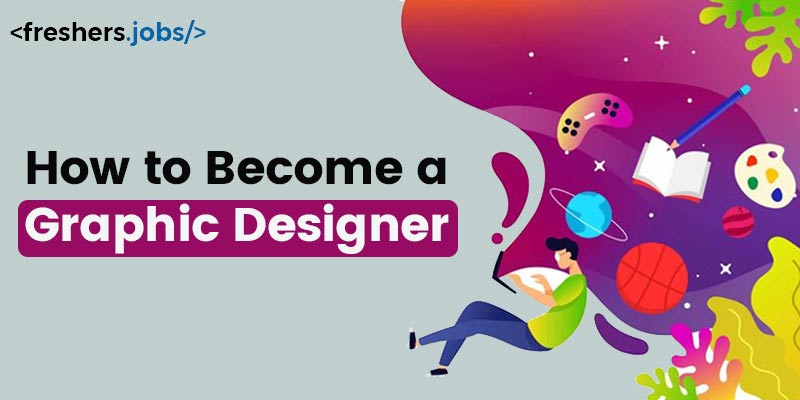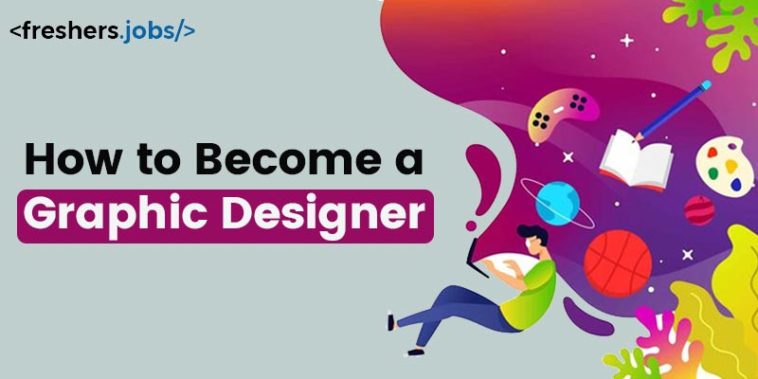Graphic designers are the creative magicians behind the visual wonders that captivate our eyes and communicate messages with stunning precision. Their artistry and technical prowess converge to shape the world around us, bringing concepts to life through captivating designs. With an interested eye for aesthetics and an unwavering passion for storytelling, graphic designers can transform ideas into captivating visuals that leave a lasting impact. This blog will convey to you how to become a graphic designer and the skills required to become a graphic designer.

Armed with their versatile toolkit of design software, typography, colour theory, and composition techniques, these masters of visual communication navigate the vast digital and print landscapes to create compelling logos, breathtaking illustrations, sleek website layouts, engaging marketing materials, and so much more. Whether conceptualising a brand identity or designing user interfaces that seamlessly blend form and function, graphic designers are the visionary architects of the visual realm, wielding their creativity to inspire, inform, and evoke emotions in their audience. Through their unique blend of artistry and technical expertise, they breathe life into pixels, shape perception, and make the world more visually captivating.
Let us know How to become a Graphic Designer
Becoming a graphic designer is an exciting and fulfilling career path that allows you to combine your creative talents with technical skills to communicate visually and make a meaningful impact. Henceforth you must know how to learn graphic design, Whether you’re drawn to logo design, branding, web design, or print media. The following in-depth guide will provide valuable insights into becoming a graphic designer.
Explore Your Passion and Develop Your Creative Skills
Graphic design is a highly creative field, so exploring your passion and career in designing art and design is essential. Engage in various artistic pursuits such as drawing, painting, photography, and typography. Experiment with different styles, techniques, and mediums to broaden your artistic perspective and develop your unique visual language. Take art classes, workshops, or online learning courses to enhance your skills and knowledge.
Pursue Formal Education or Training
While not mandatory, obtaining a formal education in graphic design or a related field can provide a solid foundation for your career. Research and enrol in reputable design schools, colleges, or universities that offer graphic design programs. These programs typically cover design principles, colour theory, typography, layout design, digital imaging, and software proficiency. They also allow you to work on projects and receive feedback from experienced instructors.
Master Design Software and Tools
Proficiency in design software is crucial for a graphic designer. Adobe Creative Suite, including Photoshop, Illustrator, and InDesign, is the industry standard and widely used. Invest time learning these tools and familiarise yourself with the latest technologies, features, functions, and shortcuts.
Build a Strong Portfolio
A compelling portfolio and graphic design requirements are your visual resume and showcase your skills, creativity, and range as a designer. Start building your portfolio by creating personal projects, designing for friends or local businesses, or participating in design competitions. Include various work, including logos, brochures, websites, packaging designs, and branding projects. Aim for quality over quantity and curate your portfolio to reflect your best work.
Having the right portfolio of a Graphic Designer, You can start applying for jobs from freshers jobs in Hyderabad.
Gain Practical Experience
Practical experience is invaluable in shaping your skills and understanding the design industry for professional graphic design. Seek internships, freelance projects, or freshers jobs positions at design studios, advertising agencies, or in-house creative departments. These opportunities allow you to work on real-world projects, collaborate with professionals, and learn how to meet clients’ expectations and deadlines.
Stay up-to-date on Design Trends and Techniques
Graphic design is a dynamic field that evolves constantly. Stay updated with current design trends, emerging techniques, and industry news. Follow design blogs, online communities, and influential designers on social media platforms to gain inspiration, learn new skills, and stay relevant. Attend design conferences, workshops, or webinars to connect with fellow designers and expand your knowledge base.
Network and Collaborate
Building a strong professional network is vital for your growth as a graphic designer. Attend design events, join design associations, and participate in local creative communities. Engage in online platforms and forums to connect with other designers, share ideas, seek feedback, and collaborate on projects. Networking can lead to valuable mentorships, job opportunities, and collaborations that can propel your career forward.
Embrace Feedback and Criticism
Getting Feedback is an important aspect of the design process and an opportunity for growth. Be open to receiving constructive criticism from clients, peers, or mentors. Actively seek feedback on your work and learn from it. Use feedback to refine your creative graphic design, strengthen your skills, and expand your creative thinking.
Beginners often choose to learn graphic design for several reasons
Creative expression: Graphic design allows individuals to express their creativity and artistic skills. It provides an outlet for creating visually appealing designs, whether it’s through illustrations, typography, or layout composition. Learning graphic design can be an exciting and fulfilling endeavour for beginners passionate about art careers and design.
Practical skills: How to become a graphic designer? Graphic design skills are highly practical in today’s digital age. Businesses, organisations, and individuals often require graphic design work for various purposes, such as creating logos, designing websites, developing marketing materials, or producing visual content for social media. By learning graphic design, beginners acquire valuable skills that can be applied professionally or for personal projects.
Career opportunities: Graphic design offers a wide range of career opportunities. It is a field or area that collaborates with many industries, including advertising, marketing, publishing, web design, branding, and more. Learning graphic design can open doors to employment prospects and freelance work, allowing beginners to pursue a creative career with a high freshers salary.
Enhanced communication: Effective graphic design has the power to communicate messages and ideas visually. By understanding design principles and techniques, beginners can learn how to create designs that effectively convey information and evoke emotions. Graphic design skills can improve one’s ability to communicate visually, which is valuable in many fields and personal endeavours.
Personal projects and hobbies: Learning the fundamentals of graphic design can be valuable for individuals with personal projects or hobbies requiring visual elements. Whether designing invitations, creating digital art, making personalised merchandise, or developing a personal brand, graphic design skills enable beginners to bring their ideas to life and enhance their projects.
Collaborative opportunities: Graphic design often involves working with others, such as clients, colleagues, or fellow designers. Learning graphic design for beginners can engage in collaborative projects, exchange ideas, receive feedback, and grow their professional network. Collaboration can lead to new opportunities, exposure to different perspectives, and overall improvement of design skills.
Overall, learning graphic design as a beginner offers the chance to cultivate creativity, acquire practical skills, explore career options, enhance communication skills, pursue personal projects, and engage in collaborative endeavours. It is a versatile discipline that can provide a fulfilling and valuable experience for individuals interested in art, design, and visual communication.
Most design companies like Tata Elxsi hires graphic designers for high salaries, So tap into Tata Elxsi jobs for freshers and land a dream company.
Skills Required to Become a Graphic Designer
Here are the key skills required for graphic designers and how to learn graphic design presented as bullet points:
- Creativity
- Visual communication
- Design principles (balance, contrast, alignment, etc.)
- Proficiency in design software (Adobe Creative Suite, Sketch, CorelDRAW, etc.)
- Typography knowledge and skills
- Attention to detail
- Time management
- Effective communication and collaboration
- Adaptability to new trends and technologies
- Problem-solving abilities
These skills collectively contribute to graphic designer’s success and ability to create impactful and visually appealing designs.
Conclusion
A graphic designer requires creativity, skills, education, experience, and a proactive approach. To embark on this career path, acquire the necessary skills in design principles, typography, and software proficiency. Pursue education and training through graphic design programs or courses, and build a diverse portfolio that showcases your skills. How to become a graphic designer? Gain practical experience through internships or entry-level positions, and stay with the latest updation with the latest design trends and technologies. Market yourself effectively and pursue opportunities that align with your goals. By following these steps and preparation tips and maintaining a passion for design, you can carve a successful path as a graphic designer.



